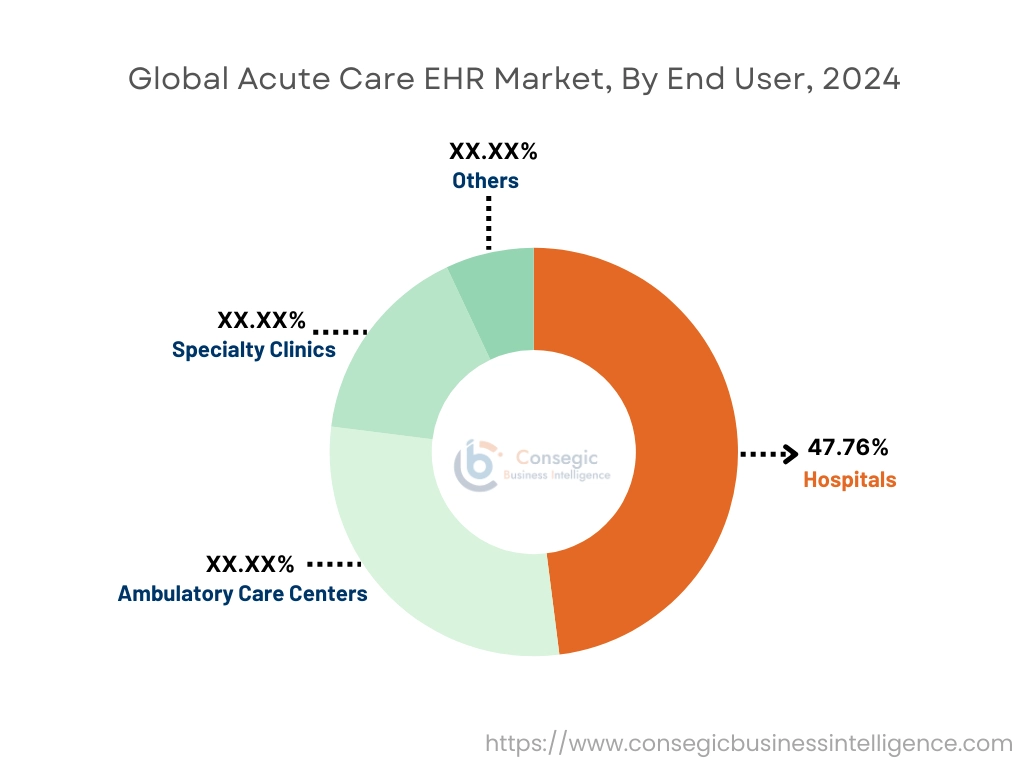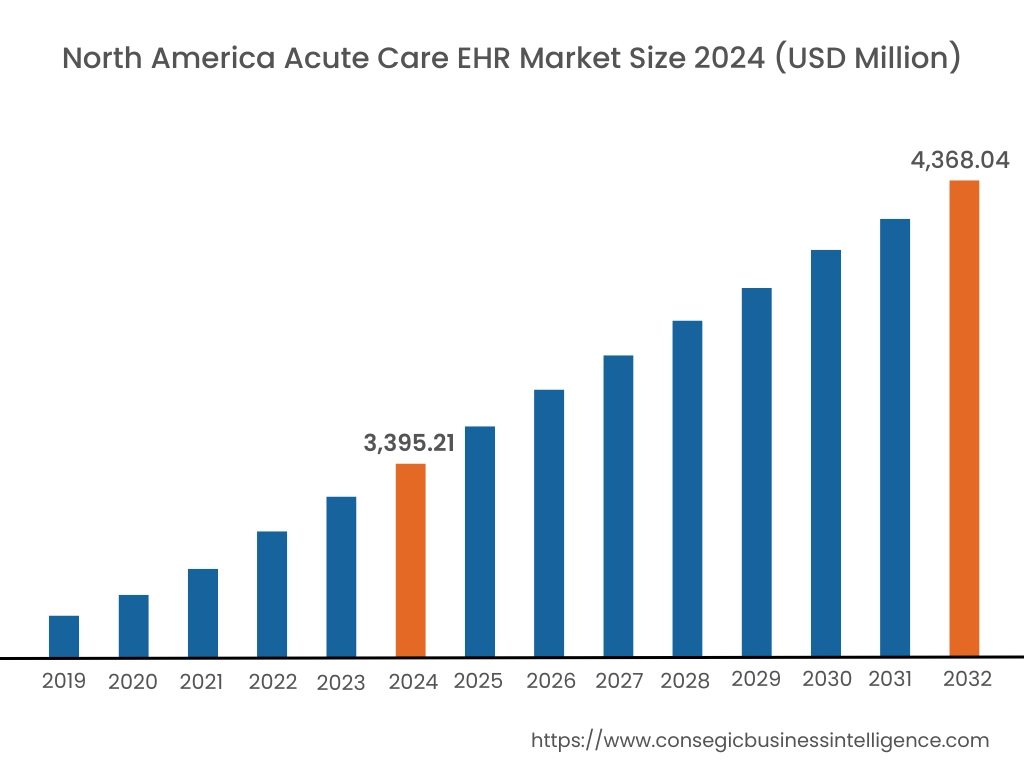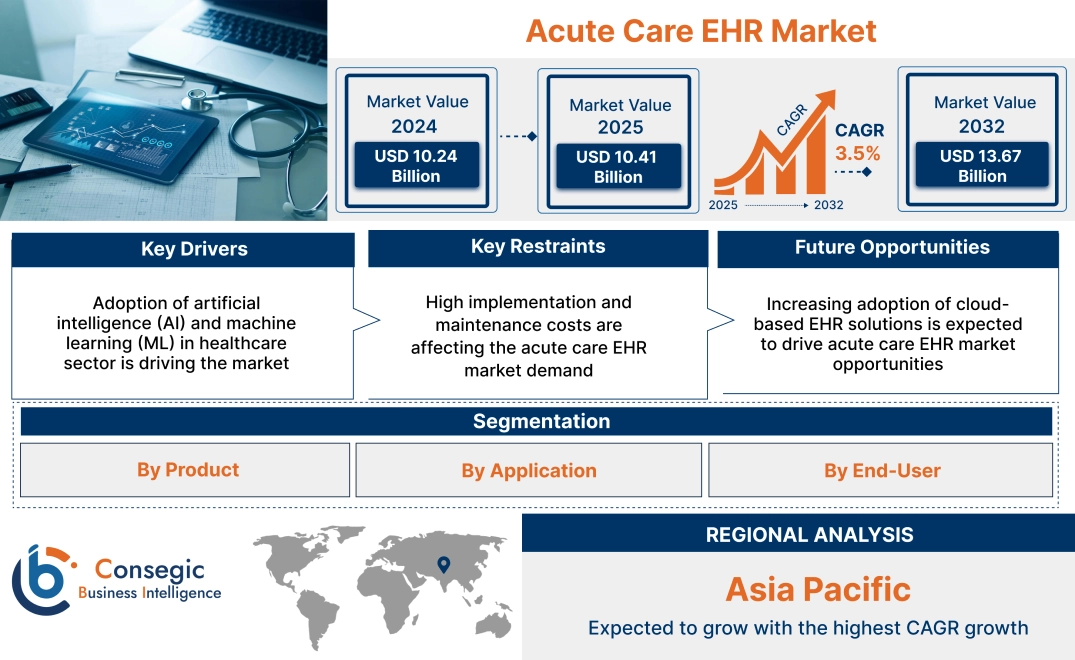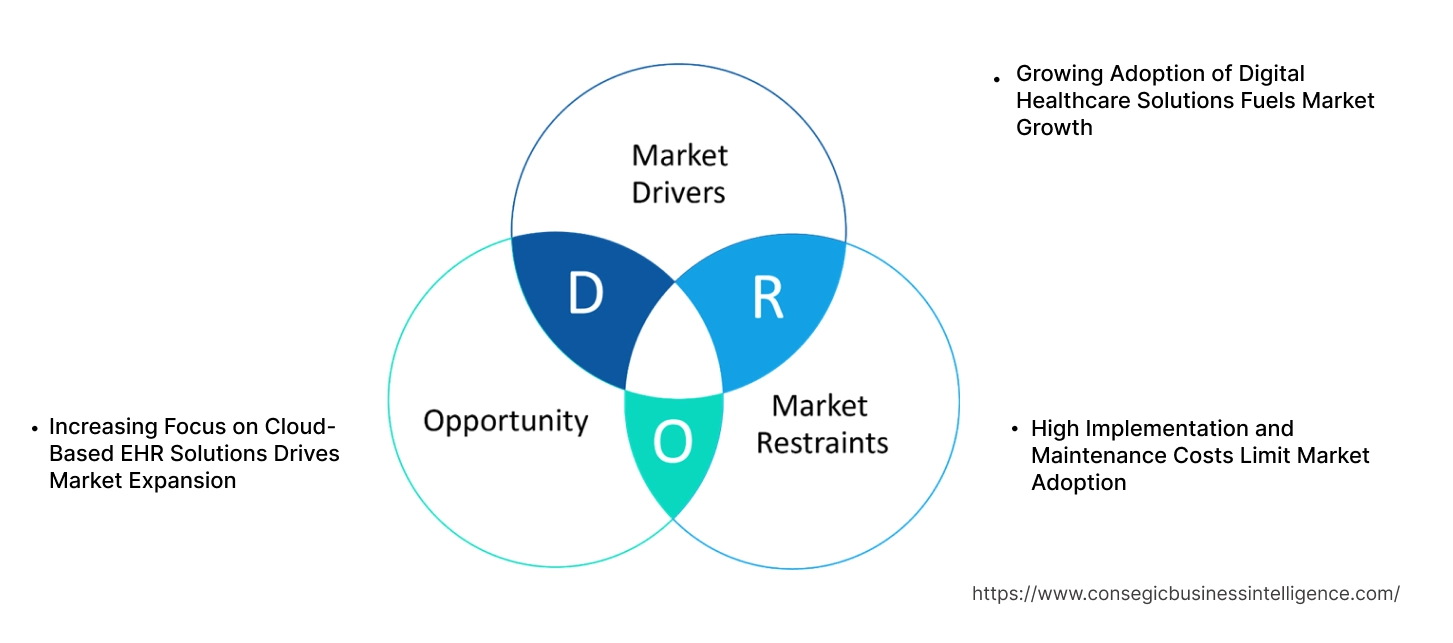- Summary
- Table Of Content
- Methodology
Acute Care EHR Market Size:
Acute Care EHR Market size is estimated to reach over USD 13,477.46 Million by 2032 from a value of USD 10,235.52 Million in 2024 and is projected to grow by USD 10,411.38 Million in 2025, growing at a CAGR of 3.5% from 2025 to 2032.
Acute Care EHR Market Scope & Overview:
The acute care EHR (Electronic Health Record) focuses on digital solutions designed to manage patient information, streamline clinical workflows, and enhance decision-making processes in acute care settings such as hospitals and emergency departments. Acute care EHR systems capture comprehensive patient data, including medical history, medications, lab results, and imaging reports, enabling real-time access for healthcare providers. Key features include patient record management, clinical decision support, computerized physician order entry (CPOE), and interoperability with other health systems. The primary benefits include improved patient care, enhanced data accuracy, reduced medical errors, and increased efficiency in clinical operations. Applications cover patient monitoring, medication management, and diagnostic support, catering to end-users like hospitals, emergency care centers, and specialized acute care facilities. The acute care EHR market growth is driven by increasing adoption of digital health technologies, regulatory mandates for EHR implementation, and the need for efficient data management in acute care settings.
Key Drivers:
Growing Adoption of Digital Healthcare Solutions Fuels Market Growth
The increasing adoption of digital healthcare solutions is a major driver for the acute care EHR (Electronic Health Record) market. Acute care EHR systems streamline patient data management, enabling real-time access to patient records, lab results, and medication histories for healthcare providers. With the rising focus on enhancing patient care and operational efficiency, hospitals and acute care facilities are rapidly transitioning from paper-based records to digital EHR solutions. Advancements in interoperability and integration capabilities have further improved the efficiency of EHR systems, allowing seamless data exchange across various healthcare departments. The shift towards digitalization in healthcare, coupled with government initiatives promoting EHR adoption, is driving acute care EHR market growth.
Key Restraints:
High Implementation and Maintenance Costs Limit Market Adoption
The market faces significant challenges due to the high costs associated with implementation and ongoing maintenance. Setting up a comprehensive EHR system requires substantial investments in software, hardware, and IT infrastructure, which can be prohibitive for small and mid-sized acute care facilities. Additionally, the need for regular software updates, cybersecurity measures, and system maintenance adds to the overall expense, making it difficult for resource-constrained hospitals to adopt EHR solutions. These financial barriers, combined with the complexity of EHR integration with existing healthcare systems, limit the widespread adoption of acute care EHR systems, especially in developing region
Future Opportunities :
Increasing Focus on Cloud-Based EHR Solutions Drives Market Expansion
The rising preference for cloud-based EHR solutions offers a promising opportunity for the market. Cloud-based systems provide scalable, cost-effective options for storing and managing patient data, reducing the need for extensive on-premises infrastructure. These solutions offer enhanced accessibility, allowing healthcare providers to access patient records remotely and collaborate more effectively across departments. The growing demand for flexible, user-friendly EHR platforms that can be easily integrated with other healthcare systems is driving the shift towards cloud-based models. As the adoption of telemedicine and remote healthcare services expands, the appeals for cloud-based acute care EHR systems is expected to grow, creating new participants for acute care EHR market opportunities.
Acute Care EHR Market Segmental Analysis :
By Product:
Based on product, the market is segmented into web-based EHR and client-server-based EHR.
The web-based EHR segment accounted for the largest revenue of the total acute care EHR market share in 2024.
- Web-based EHR systems are increasingly preferred due to their ease of access, scalability, and lower upfront costs.
- These systems allow healthcare providers to access patient data from any location, facilitating seamless care coordination and enhancing workflow efficiency.
- The rapid adoption of telehealth and remote patient monitoring during the COVID-19 pandemic highlighted the benefits of web-based EHR systems, driving their demand.
- Additionally, the flexibility of web-based solutions in integrating with various healthcare applications and devices supports their dominant market position.
- Thus, web-based EHR systems lead the acute care EHR market trends, driven by their accessibility, scalability, and growing adoption in telehealth and remote patient care.
The client-server-based EHR segment is anticipated to register steady growth during the forecast period.
- Client-server-based EHR systems offer greater data control and security, making them a preferred choice for larger healthcare facilities with extensive IT infrastructure.
- These systems store patient data on local servers, reducing the risk of data breaches and providing faster access times within the facility’s network.
- Despite the increasing popularity of cloud solutions, client-server-based EHRs remain relevant for institutions prioritizing data privacy and internal control.
- The need for robust, secure systems in compliance with regulatory standards continues to drive demand for client-server EHRs.
- As per the market analysis, Client-server-based EHR systems continue to be adopted by healthcare industries requiring enhanced data control and security, driving the acute care EHR market expansion.
By Type:
Based on type, the market is segmented into ambulatory, post-acute, and acute EHR systems.
The acute EHR segment accounted for the largest revenue share in 2024.
- Acute EHR systems are specifically designed for use in hospital settings, where comprehensive patient records and real-time data access are critical for delivering quality care.
- These systems streamline clinical workflows, enable better patient management, and support critical decision-making processes.
- The growing focus on improving patient outcomes, coupled with the increasing adoption of electronic health records in hospitals, is driving advancement for acute EHR systems.
- The integration of advanced features like clinical decision support (CDS) and computerized physician order entry (CPOE) further enhances their utility in acute care settings.
- Thus, the analysis shows acute care EHR systems dominate the market trends, driven by their critical role in healthcare industries for improving clinical workflows and supporting decision-making processes.
The ambulatory EHR segment is anticipated to register the fastest CAGR during the forecast period.
- Ambulatory EHR systems are tailored for outpatient care settings, including clinics and primary care centers.
- These systems facilitate efficient patient management, streamline administrative tasks, and support comprehensive documentation of clinical encounters.
- The shift towards value-based care and the increasing emphasis on preventive healthcare services are boosting the adoption of ambulatory EHRs.
- The segment’s development is further supported by advancements in interoperability and integration capabilities, enabling seamless data exchange with other healthcare systems.
- Therefore, ambulatory EHR systems analysis expected to grow rapidly, driven by the shift towards outpatient care trends and advancements in interoperability, supporting improved care coordination.
By Application:
Based on application, the market is segmented into administrative task and billing, clinical records, physician support, and others.
The clinical records segment accounted for the largest revenue in acute care EHR market share in 2024.
- The clinical records function of EHR systems is central to maintaining comprehensive, accurate patient data, enabling healthcare providers to make informed decisions.
- This segment includes features like patient history documentation, lab results, and clinical notes, which are crucial for effective patient management.
- The increasing emphasis on data-driven healthcare and the need for integrated patient records across multiple care settings drive the demand for robust clinical records solutions.
- Additionally, regulatory mandates for accurate electronic documentation, such as the Meaningful Use program in the U.S., further support this segment’s trends.
- The clinical records segmental analysis leads the market due to its essential role in maintaining comprehensive patient data and the growing emphasis on data-driven healthcare practices.
The administrative task and billing segment is anticipated to register the fastest CAGR during the forecast period.
- EHR systems designed for administrative tasks and billing streamline financial operations, reduce errors, and enhance revenue cycle management.
- The growing adoption of EHR solutions for automating billing processes and improving administrative efficiency is driving the trends of this segment.
- Features like automated claim submissions, coding assistance, and integrated payment systems enhance the accuracy of billing and reduce delays in payment processing.
- The increasing focus on optimizing financial workflows and reducing administrative burdens in healthcare facilities further supports the rapid trends of this segment.
- Thus, according the administrative task and billing applications acute care EHR market analysis expected to grow rapidly, driven by the increasing focus on revenue cycle optimization and the need for efficient financial management in healthcare facilities.
By End-User:
Based on end-user, the market is segmented into hospitals, ambulatory care centers, specialty clinics, and others.
The hospitals segment accounted for the largest revenue share of 47.76% in 2024.
- Hospitals are the primary users of acute care EHR systems due to their need for comprehensive, integrated solutions that can handle complex clinical workflows and large volumes of patient data.
- EHR systems in hospital settings support critical functions like clinical documentation, order entry, and decision support, enabling efficient patient management and improved care outcomes.
- The increasing adoption of EHR systems in hospitals, driven by regulatory incentives and the push towards digital transformation in healthcare, supports the dominance of this segment.
- Additionally, the integration of advanced features like predictive analytics and telemedicine capabilities enhances the utility of EHR systems in hospitals.
- Hospitals lead the market, driven by their need for comprehensive EHR solutions that support complex clinical workflows and the ongoing push towards digital healthcare transformation.
The ambulatory care centers segment is anticipated to register the fastest CAGR during the forecast period.
- Ambulatory care centers are increasingly adopting EHR systems to streamline patient management, enhance clinical efficiency, and improve care coordination.
- The shift towards outpatient care, driven by the focus on reducing hospital admissions and healthcare costs, is boosting the adoption of EHR systems in ambulatory settings.
- The ability of EHRs to integrate with practice management systems and support features like appointment scheduling and patient reminders further enhances their value in these centers.
- The trend towards value-based care and the need for efficient, patient-centered documentation are key drivers for this segment’s rapid growth.
- Ambulatory care centers are expected to grow rapidly, driven by the shifting trends towards outpatient care and the increasing need for efficient, integrated EHR systems that enhance patient management and care coordination, which further fuels the acute care EHR market opportunities.

Regional Analysis:
The regions covered are North America, Europe, Asia Pacific, the Middle East and Africa, and Latin America.

In 2024, North America was valued at USD 3,395.21 Million and is expected to reach USD 4,368.04 Million in 2032. In North America, the U.S. accounted for the highest share of 75.25% during the base year of 2024. North America dominates the acute care EHR market analysis, primarily due to extensive digitalization of healthcare and strong government mandates for electronic health record adoption. The U.S. leads the region, driven by the implementation of federal initiatives like the Health Information Technology for Economic and Clinical Health (HITECH) Act, which incentivizes hospitals and healthcare providers to adopt EHR systems. The region also benefits from a high level of integration between EHR systems and advanced healthcare IT infrastructure, enabling seamless patient data management. Canada is increasingly investing in acute care EHRs, focusing on enhancing patient data accessibility across its healthcare industries. However, issues related to data interoperability and cybersecurity remain significant challenges in the region.

In Asia Pacific, the market is experiencing the fastest growth with a CAGR of 3.9% over the forecast period. Asia-Pacific is the fastest-growing region in the acute care EHR market, driven by rapid healthcare modernization, increasing government investments, and the growing need for efficient patient data management in countries like China, Japan, and India. China’s focus on healthcare digitalization and the rollout of national EHR initiatives are boosting acute care EHR market demand. Japan’s advanced healthcare system is integrating EHRs with telemedicine services to enhance acute care, particularly for its aging population. In India, the adoption of acute care EHRs is accelerating, supported by government initiatives like the Ayushman Bharat Digital Mission, which aims to create a nationwide digital health infrastructure. However, challenges such as diverse regulatory environments and limited interoperability between systems hinder the market’s full potential.
Europe is a key market for acute care EHRs, supported by growing investments in healthcare IT and an increasing focus on improving clinical outcomes through digital health solutions. Countries like Germany, the UK, and France are leading in EHR adoption, with a strong emphasis on integrating EHRs into national health services to enhance patient care. Germany’s ongoing healthcare digitalization initiatives and the UK’s NHS Digital Transformation Plan are driving the acute care EHR market demand, particularly in hospitals and emergency care settings. The European market, however, faces challenges related to stringent data protection regulations under the General Data Protection Regulation (GDPR), which can complicate the implementation of EHR systems.
The Middle East & Africa region is experiencing steady advancement in the acute care EHR market, driven by increasing investments in healthcare infrastructure and digital health solutions in the UAE, Saudi Arabia, and South Africa. The UAE’s focus on healthcare modernization, including the implementation of nationwide EHR systems, is driving acute care EHR market trends. Saudi Arabia’s Vision 2030 emphasizes the expansion of digital health services, boosting the acute care EHRs market opportunities in hospitals and emergency care units. South Africa is also investing in EHR systems to improve patient care and streamline hospital operations. However, limited local expertise and the high costs of implementing EHR systems pose challenges, particularly in less-developed parts of the region.
Latin America is an emerging market for acute care EHRs, with Brazil and Mexico leading the way. The region’s growth is driven by increasing healthcare IT investments and a growing emphasis on improving clinical efficiency in acute care settings. Brazil’s government is actively promoting the adoption of EHRs to enhance patient care, especially in public hospitals. Mexico’s healthcare modernization efforts, including the integration of EHRs in emergency care facilities, are contributing to acute care EHR market expansion. However, challenges such as limited funding, economic constraints, and varying levels of digital literacy among healthcare providers can affect the adoption of acute care EHRs across the region.
Top Key Players & Market Share Insights:
The Acute Care EHR market is highly competitive with major players providing products and services to the national and international markets. Key players are adopting several strategies in research and development (R&D), product innovation, and end-user launches to hold a strong position in the global Acute Care EHR market. Key players in the Acute Care EHR industry include -
- Epic Systems Corporation (USA)
- Cerner Corporation (USA)
- eClinicalWorks (USA)
- GE Healthcare (UK)
- NextGen Healthcare (USA)
- Veradigm Inc (USA)
- McKesson Corporation (USA)
- Athenahealth, Inc. (USA)
- Meditech (USA)
- Greenway Health (USA)
Acute Care EHR Market Report Insights:
| Report Attributes | Report Details |
| Study Timeline | 2019-2032 |
| Market Size in 2032 | USD 13,477.46 Million |
| CAGR (2025-2032) | 3.5% |
| By Product |
|
| By Type |
|
| By Application |
|
| By End-User |
|
| By Region |
|
| Key Players |
|
| North America | U.S. Canada Mexico |
| Europe | U.K. Germany France Spain Italy Russia Benelux Rest of Europe |
| APAC | China South Korea Japan India Australia ASEAN Rest of Asia-Pacific |
| Middle East and Africa | GCC Turkey South Africa Rest of MEA |
| LATAM | Brazil Argentina Chile Rest of LATAM |
| Report Coverage |
|
Key Questions Answered in the Report
What is the size of the acute care EHR market? +
Acute Care EHR Market size is estimated to reach over USD 13,477.46 Million by 2032 from a value of USD 10,235.52 Million in 2024 and is projected to grow by USD 10,411.38 Million in 2025, growing at a CAGR of 3.5% from 2025 to 2032.
What is the projected growth rate of the acute care EHR market? +
The market is expected to grow at a CAGR of approximately 5-6% over the next five years.
How is AI impacting the acute care EHR market? +
AI integration is improving clinical decision-making, data analytics, and personalized patient care in acute care settings.
Which region dominates the acute care EHR market? +
North America leads due to advanced healthcare infrastructure and widespread adoption of digital healthcare solutions.
Which factors are driving the growth of this market? +
The need for real-time patient data, rising hospital admissions, and government incentives for EHR adoption are key drivers.


